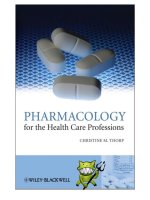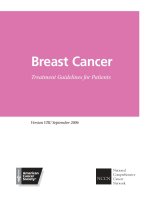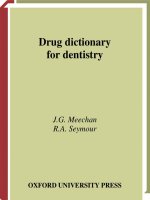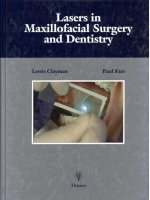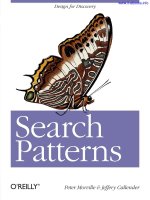Pharmacology for Dentistry potx
Bạn đang xem bản rút gọn của tài liệu. Xem và tải ngay bản đầy đủ của tài liệu tại đây (5.02 MB, 501 trang )
This page
intentionally left
blankCopyright © 2007, New Age International (P) Ltd., Publishers
Published by New Age International (P) Ltd., Publishers
All rights reserved.
No part of this ebook may be reproduced in any form, by photostat, microfilm,
xerography, or any other means, or incorporated into any information retrieval
system, electronic or mechanical, without the written permission of the publisher.
All inquiries should be emailed to
PUBLISHING FOR ONE WORLD
NEW AGE INTERNATIONAL (P) LIMITED, PUBLISHERS
4835/24, Ansari Road, Daryaganj, New Delhi - 110002
Visit us at www.newagepublishers.com
ISBN (13) : 978-81-224-2556-7This page
intentionally left
blank
Pharmacology has undergone major intellectual changes in the recent years and has become
increasingly important to all medical, dental and other health professionals. The graduate
students of dentistry may have to handle medical emergency during various dental
procedures on the dental chair. Besides this, dentists have to look into various drug
associated interactions. The broad goal of teaching pharmacology to undergraduate
students is to inculcate rational and scientific basis of therapeutics keeping in view the
dental curriculum and profession. A sincere attempt has been made to present a complete
text for undergraduate students of dentistry as per the new syllabus requirement (Dental
Council of India, BDS course regulation, 2006).
The book is divided into thirteen sections, initial sections cover the general and
autonomic pharmacology, followed by other sections of drug acting on different body
systems. A detailed section is devoted only to dental pharmacology which covers all agents
used in pharmacotherapy of dental conditions. The last section covers vaccine, sera and
other immunological agents and drugs used in skin disorders. The chapters have been
arranged in such a way that knowledge gained from initial chapters will be helpful to
students for understanding subsequent chapters. The appendix contains the list of newly
approved and banned drugs in India.
The classification adopted in the books provides pharmacological distinction among
latest drugs with doses and routes of administration along with leading trade name(s)
available in Indian market, but it should not be construed as the recommendation of those
particular brands.
Preface
Preface
(viii)
Thanks are due to New Age International (P) Ltd., N. Delhi for their keen interest and
attention in bringing out this book in its present form. Further, I am indebted to all my
friends and well wishers for their support and encouragement.
I would like to express my gratitude and indebtedness to all my family members for
their sacrifice, affection and inspiration throughout the present work.
New Delhi Surender Singh
(ix)
Preface (vii)
SECTION 1
General Principles of Pharmacology
1.1 Sources and Nature of Drug Dosage Form 3
1.2 Prescription Writing 15
1.3 Rational Use of Drugs & Drug Laws 19
1.4 Pharmacokinetics 25
(Absorption, Distribution, Metabolism and Excretion of Drugs)
1.5 Pharmacodynamics (Mode of Action of Drugs) 39
1.6 Adverse Drug Reactions 47
1.7 Drug Interactions 51
SECTION 2
Drugs Acting on CNS
2.1 General Anaesthetics 61
2.2 Sedative & Hypnotics 69
2.3 Narcotic Analgesics (Opioids) 75
2.4 Non-Narcotic Analgesics (NSAID’s) 83
Contents
Contents
(x)
2.5 Psychotropic Agents 95
2.6 Antiepileptic Agents 105
2.7 Muscle Relaxants 111
2.8 Local Anaesthetics 115
2.9 CNS Stimulants 119
2.10 Drugs Used in Parkinsonism 123
SECTION 3
Drugs Acting on ANS
3.1 Sympathomimetics (Adrenergic Agents) 131
3.2 Treatment of Shock & Vasopressor Agents 141
3.3 Sympatholytics (Antiadrenergic Agents) 145
3.4 Parasympathomimetics (Cholinergic Agents) 155
3.5 Parasympatholytics (Anticholinergic Agents) 161
SECTION 4
Drugs Acting on Cardiovascular & Urinary System
4.1 Cardiotonics (Cardiac Glycosides) 169
4.2 Antihypertensive Agents 175
4.3 Antianginal Agents 185
4.4 Antiarrhythmic Agents 189
4.5 Antihyperlipidemic Agents 195
4.6 Plasma Expanders 199
4.7 Diuretics and Antidiuretics 203
SECTION 5
Autacoids
5.1 Histamine and Antihistaminic Agents 215
5.2 Serotonin and its Antagonists 221
5.3 Prostaglandins and Leukotrienes 225
5.4 Drugs Used in Cough and Asthma 229
(xi)
SECTION 6
Drugs Acting on Blood
6.1 COAGULANTS AND ANTICOAGULANTS 239
6.2 H
AEMATINICS (Drugs Used in Anaemia) 247
SECTION 7
Drugs Acting on GIT
7.1 Laxatives and Antidiarrhoeal Agents 253
7.2 Emetics & Antiemetic Agents 257
7.3 Antacids and Antiulcer Agents 261
SECTION 8
Drugs Acting on Endocrine System
8.1 Anterior Pituitary Hormones 269
8.2 Antidiabetic Agents 275
8.3 Glucocorticoids & Sex Hormones 281
8.4 Thyroid Hormone & Antithyroid Agents 293
8.5 Hormonal Contraceptives 297
SECTION 9
Chemotherapy
9.1 Sulfonamides, Nitrofurans and Quinolones 303
9.2 Tetracyclines, Chloramphenicol and Chemotherapy of UTI 311
9.3 Beta Lactam Antibiotics 317
9.4 Aminoglycosides Antibiotics 327
9.5 Macrolide and Polypeptide Antibiotics 331
9.6 Antiviral Agents 337
9.7 Antifungal Agents 343
9.8 Antimalarial Agents 349
9.9 Antiamoebic and other Antiprotozoal Drugs 355
9.10 Anthelmintic Agents 361
9.11 Chemotherapy of Tuberculosis 365
(xii)
9.12 Chemotherapy of Leprosy 369
9.13 Chemotherapy of Malignancy 371
SECTION 10
Vitamins and Trace Elements
10.1 Vitamins and Trace Elements 383
SECTION 11
Chelating Agents & Treatment of Poisoning
11.1 Chelating Agents & Treatment of Poisoning 395
SECTION 12
Dental Pharmacology
12.1 Antiseptics & Disinfectants 407
12.2 Astringent and Obtundents 413
12.3 Mummifying and Bleaching Agents 415
12.4 Styptics (Local Haemostatics) and Disclosing Agents 417
12.5 Dentifrices and Mouth Washes 419
12.6 Caries and Fluorides 423
12.7 Pharmacotherapy of Common Oral Conditions & Dental Emergencies 425
SECTION 13
Miscellaneous
13.1 Vaccines, Sera and Other Immunological Agents 431
13.2 Drugs Used in Skin Disorders 449
APPENDICES
Appendix I : List of Recently Approved New Drugs and Combinations
in India (During 1999-July 2006) 459
Appendix II : List of Banned Drugs and Fixed Dose Combinations
in India (Updated till January 2007) 473
Index 477
General Principles
of
Pharmacology
Section 1
Section 1
This page
intentionally left
blank
INTRODUCTION
Pharmacology (derived from Greek words,
pharmacon-drug; logos-discourse in) consists
of detailed study of drugs – its source, physi-
cal and chemical properties, compounding,
biochemical and physiological effects, phar-
macodynamics (its mechanism of action),
pharmacokinetics (absorption, distribution,
biotransformation and excretion), therapeu-
tic and other uses of drugs.
According to WHO definition ‘Drug is
any substance or product that is used or
intended to be used to modify or explore
physiological system or pathological states
for the benefit of the recipient’.
Pharmacology has some major subdivi-
sions:
Pharmacodynamics is the study of the
biochemical and physiological effects of the
drugs and their mechanism of action.
Pharmacotherapeutics deals with the
use of drugs in the prevention and treatment
of diseases and it utilizes or depends upon
the information of drug obtained by
pharmacodynamic studies.
Pharmacokinetics deals with the
alterations of the drug by the body which
includes absorption, distribution, binding/
storage, biotransformation and excretion of
drugs.
Toxicology deals with the side/adverse
effects and other poisonous effects of drugs,
since the same drug can be a poison,
depending on the dose.
Chemotherapy deals with the effects of
drugs upon microorganisms and parasites
without destroying the host cells.
Pharmacology also includes certain
allied fields as:
Pharmacy is the science of preparation,
compounding and dispensing of drugs. It is
concerned with collection, identification,
purification, isolation, synthesis and stan-
dardization of medicinal /pharmaceutical
substances.
Pharmacognosy deals with the study of
the sources of drugs derived from plants and
animal origin.
Chapter
1. 4
Chapter
1.1
Sources and Nature
of
Drug Dosage Form
Sources and Nature
of
Drug Dosage Form
Section 1/ General Principles of Pharmacology4
Materia-medica: This is an older term
and deals with the source, description
(physical and chemical properties) and
preparation of drugs.
Pharmacopoeia is an official reference
containing a selected drugs/medicinal
preparations with their description, tests for
their identity, purity and potency and with their
average doses. A few famous pharmacopoeia
and other reference books are the Indian
Pharmacopoeia (IP), the British Pharmacopoeia
(BP); the United States Pharmacopoeia (USP);
the British Pharmaceutical Codex (BPC); the
National Formulary (NF) i.e. British National
Formulary (BNF) and National Formulary (NF)
of India. It is necessary for understanding the
each aspects of pharmacology by dentists, as
they have to prescribe the drug for the treatment
of various dental conditions in general and
other concurrently disease with many of the
dental patients. The dentists should be aware
of drug interactions and capable of handle any
emergency during any dental procedure.
SOURCES OF DRUGS
‘Drug’ is derived from French word ‘drogue’
means a dry herb. Drugs are obtained
mainly from plants, animals, microbes and
mineral sources, but a majority of them that
are used therapeutically are from synthetic
or semi-synthetic products.
PLANT ORIGIN
The pharmacologically active compo-
nents in vegetable drugs are:
i. Alkaloids are basic substances
containing cyclic nitrogen. The
important alkaloids are obtained from:
• Opium (Papaver somniferum): Mor-
phine group.
• Cinchona (Cinchona officinalis): Qui-
nine etc.
• Belladonna (Atropa belladonna): At-
ropine group.
• Pilocarpus sp.: Pilocarpine.
• Vinca (Vinca rosea): Vincristine,
vinblastine.
• Rauwolfia serpentina (root): Reserpine.
• Coca (Erythroxylum coca): Cocaine.
ii. Glycosides are ether like organic
structure combined with sugars, the
non-sugar component called aglycone
or genin. The important glycosides are:
• Digitalis (Digitalis purpurea, Digitalis
lanata): Digoxin etc.
• Stropanthus (Stropanthus kombe):
Stropanthin etc.
• Senna (Cassia acutifolia): Sennoside etc.
iii. Oils
a. Fixed oils are glycerides of oleic, palmitic
and stearic acids. Mostly fixed oils are
edible and used for cooking. The fixed
oils used as drug are:
• Castor (Ricinus communis): Castor oil.
• Olive (Olea europaea): Olive oil.
• Cocoa butter (Theobroma cacao):
Theobroma oil used as emollient
in skin cream and making sup-
positories.
• Cod liver oil and shark liver oil:
Rich source of vitamin A and D.
b. Volatile oil or essential oil contains
the hydrocarbon terpene. The
important volatile oils are:
• Turpentine oil, from species of
pines, used as a counterirritant.
• Lemon oil (from Citrus limon), used
as flavouring agent.
• Peppermint, cardamom and fen-
nel used as carminative and
flavouring agent.
Sources and Nature of Drug Dosage Form
5
• Oil of clove is mainly useful in
relieving pain in toothache.
iv. Resins are produced by oxidation and
polymerization of volatile oils. The
different types of resins are:
• Oleoresins: Male fern extract used
for tapeworm infestation.
• Gum resins: Asafoetida, used as
carminative and antispasmodic.
• Oleo gum resin: Myrrh, it has a local
stimulant and antiseptic properties
and generally used in mouthwash.
• Balsams: Benzoin, used internally
as expectorant and externally as
astringent.
• Balsam Tolu, used as stimulating
expectorant.
v. Gums are the secretory products of
plants. On hydrolysis they yield simple
sugar like polysaccharides. They are
pharmacologically inert substances
and mainly employed as suspending
and emulsifying agent in various
pharmaceutical products.
The widely used preparations are gum
acacia and tragacanth.
vi. Tannins are nonnitrogenous constitu-
ents of plant. Chemically they are phe-
nolic derivatives and are characterized
by their astringent action. Tannins are
generally employed in the treatment of
diarrhoea and burns. The important
plants which contains tannins are:
Amla, Behera, Hirda (in combination
form ‘Triphala’), Black catechu and
Ashoka bark.
ANIMAL SOURCES
The different animal products after
purification in a suitable dosage form for the
treatment of disease are listed in table 1.1.1.
FROM HUMAN BEING
There are certain products which are
obtained from human being e.g.
• Immunoglobulins: From blood.
• Placental extract: From placenta.
• Chorionic gonadotropin: From urine
of pregnant women.
• Growth hormone: From pituitary
gland.
FROM MICROORGANISMS
The different classes of drugs obtained/
isolated from microbes are:
• Penicillin: Penicillium chrysogenum
and notatum (Fungus).
• Streptomycin: Streptomyces griseus
(Actino-mycetes).
• Erythromycin: Streptomyces erythreus
(Actinomycetes).
• Chloramphenicol: Streptomyces
venezuelae (Actinomycetes).
• Tetracyclines: Streptomyces aureofaciens
and rimosus (Actinomycetes).
• Polymyxin B: Bacillus polymyxa.
• Bacitracin: Bacillus subtilis.
• Nystatin: Streptomyces nouresi.
• Griseofulvin: Penicillium griseofulvum.
Apart from various other antibiotics
obtained from microorganisms, there are
other products that are also produced by
microorganisms. They are:
• Streptokinase, an enzyme from gram
positive cocci (Streptococcus pyogenes).
• Vitamin B
12
(cyanocobalamin):
Streptomyces griseus.
Section 1/ General Principles of Pharmacology6
ROUTES OF DRUG ADMINISTRATION
The drugs can be administered by a variety
of routes, either locally or administered orally
and by injection. To produce local effects,
drugs are applied topically to the skin or
mucous membranes. To produce systemic
effects drugs are administered orally, rectally,
parenterally or by inhalation route.
The choice of the route in a given
situation depends upon the drug and the
patient’s condition (e.g. in unconscious and
vomiting state), and urgency of treatment
(whether the routine treatment or in
emergency condition).
The important routes of administration
are:
LOCAL ROUTES
The dosage forms applied locally to the
skin are powders, paste, lotions, ointments,
creams, plasters and jellies. They are used
for their antiseptic, antipruritic, analgesic,
local anaesthetic and other related effects.
The absorption of drug through the skin
is proportional to the surface area covered
and to their lipid solubility. The dermis layer
is freely permeable to many fluids.
Inflammatory and other related conditions
which increase the cutaneous blood flow
also enhance absorption of drugs.
Absorption through the skin can be
enhanced by induction (rubbing the oily
vehicle preparation into the skin) also.
On the skin, drug is applied in the form
of ointment, cream, lotion, paste, plaster,
powder etc.
The topical application is also used on
the mucous membranes i.e. nose, throat, eye,
ear, bronchi, rectum, urethra, vagina and
rectum.
In case of mouth and pharynx, the drug
is used in the form of throat paints, lozenges,
gargles or mouth washes.
In case of corneal application (in the
form of ointments, drops), the drug may
penetrate the anterior chamber and affect the
ciliary muscle. The nasal mucosa is treated
with drug solution in the form of spray or
irrigation.
The bronchial mucosa and lungs are
treated with inhalations, aerosols (in the form
of fine powder with the help of nebulizer) e.g.
salbutamol (ASTHALIN) inhaler.
Table 1.1.1: Classification of different animal products used as drug and surgicals.
Drug Category Animal source
Insulin Hormone Pancreas of beef or pig
Thyroid extract/thyroxine Hormone Thyroid gland
Shark liver oil Vitamin A Livers of shark and allied species
Cod liver oil Vitamin A and D Livers of Gadus species
Antisnake venom Immune serum Blood of horse
Hyaluronidase Enzyme Testis of bull
Pepsin Enzyme Stomach of beef and pig
Surgical ligatures and sutures Used in surgery Intestinal tissues, tendons of animals.
Sources and Nature of Drug Dosage Form
7
Drugs may also be administered locally
in the form of bougies, jellies for urethra,
pessaries, vaginal tablets, creams and
douches for vagina and suppositories for
rectal administration.
Due to the rich blood and lymph supply
to rectum the unionised and lipid soluble
substances are readily absorbed from the
rectum. The advantages of this route are
that gastric irritation is avoided and easy
administration by the patient himself.
Administration of drug in the form of
liquid into the rectum is called enema,
which may be soap water or glycerine-
vegetable oil. It is used to remove the
faecal matter and flatus and is
used in constipation. Certain drugs are
administered rectally for producing
systemic effects also (e.g. aminophylline,
indomethacin, paraldehyde etc.).
SYSTEMIC ROUTES
The drug administered through
systemic routes (orally or parenterally), is
absorbed into the blood, distributed along
through the circulation and produce their
desired effects.
Oral Route
This is the most commonly used route
for drug administration. It is also the safest,
most convenient and economical. But, there
are some limitation of this route:
• Drug action is slow, thus not suitable
for emergencies.
• Incapability to absorb some drugs, due
to their physical characteristics i.e.
polarity of the drug.
• Unpalatable and other irritant drugs
can not be administered.
• Can not be used for unconscious and
uncooperative patient.
• May not be useful in the presence of
vomiting and diarrhoea.
• Drugs, which can be destroyed by di-
gestive juices (i.e. insulin, penicillin
G) or in liver (i.e. testosterone, nitro-
glycerine) can not be administered
orally.
• The absorption of certain drugs is
negligible e.g. streptomycin.
Enteric Coated Tablets
The drugs which are destroyed by
the gastric juices in the stomach, are
coated with keratin, shellac and cellulose
acid phosphate. These substances are not
dissolved by the acid juice of the
stomach, but are dissolved in the
intestinal juice (alkaline) only, which is
useful in:
• Preventing gastric irritation and
alteration of the drug in the stomach.
• To get the desired concentration of
the drug in intestine.
• To delay the absorption of the drug.
Time Release/Sustained Release Capsules
It is a useful solid dosage form of drug,
where the particles of the drug dissolve at
different time intervals.
The advantages of time-release prepara-
tions are:
• Reduction in the frequency of admin-
istration of drug.
Section 1/ General Principles of Pharmacology8
• Maintenance of therapeutic effect for
longer time.
• To some extent decreased incidence of
undesired effects.
• Appropriate for drugs with short half
lives (less than 4 hours).
Sublingual Administration
The highly lipid soluble and
nonirritating drugs (i.e. nitroglycerine,
isoprenaline, methyltestosterone) in the
form of tablets or pellet is placed under the
tongue, where they rapidly dissolve and are
absorbed quickly in the general circulation.
The advantages of this routes are:
• Rapid onset of action.
• The degradation and metabolism of the
drugs in the stomach and liver is
avoided
PARENTERAL ROUTES
(par = beyond, enteral = intestinal)
The administration of drugs by injection
directly into the tissue fluid or blood without
having to cross the intestinal mucosa.
The advantages of parenteral routes are:
• Rapid action of drug.
• Can be employed in unconscious/
uncooperative patients.
• Drugs, which are modified by
alimentary juices and liver can be given
by this route.
• Drugs, which are not absorbed in small
intestine or irritate the stomach can be
administered by this route.
Disadvantages are:
• Less safe, more expensive.
• Inconvenient (painful) for the patient.
• Self medication is difficult.
• Chances of local injury at the site of
injection.
The important parenteral routes are:
Subcutaneous
The non-irritant substances can be
injected by this route. The rate of
absorption of drug is constant and slow to
provide a sustained effect. The site of
injection is usually the outer surface of the
arm, or front of the thigh. Self medication
(e.g. insulin) is possible because deep
penetration is not needed. Other drugs
which are administered subcutaneously are
adrenaline, morphine and certain hormonal
preparations.
The other related subcutaneous routes
are dermojet (by which, drug is projected
from a microfine orifice using a high ve-
locity jet) and pellet implantation (which
provides sustained release of the drug
over weeks and months e.g. testosterone).
Intramuscular
The soluble substances, mild irritants
and suspensions can be injected by this
route in the large skeletal muscles (deltoid,
triceps, gluteus maximus, rectus femoris
etc.). These muscles are less richly supplied
with sensory nerves and are more vascular,
so irritant solutions can be injected. Small
volumes (up to 2 ml) are injected into the
deltoid muscle, and small or large volumes
(up to 10 ml) are injected into the gluteal
mass.
The rate of absorption is reasonably
uniform and the onset of action is rapid.
Sources and Nature of Drug Dosage Form
9
Intravenous
The drug is injected as a bolus or infused
slowly directly into a vein to produce rapid
action. It is also useful for certain irritant and
hypertonic solutions, as they are rapidly
diluted by the blood. Drugs in an oily vehicle
or those which precipitate blood constituents
or haemolyze erythrocytes should not be
given by this route.
Intravenous route is the most rapidly
effective and the desired blood concentration
can be obtained with a definite dose but at
the same time it is the most dangerous route
of administration. For once the drug is
injected there is no retreat. So, intravenous
injection must usually be performed slowly
and with constant monitoring of the patient.
This route is usually reserved for emergencies
when a rapid action is required and infusion
of large amounts of fluids to overcome
dehydration or to supply nutrition to patients
who can not take food/fluids orally.
Intradermal
The drug is injected into the skin raising
a bleb. This route is employed for vaccination
e.g. BCG vaccine and for testing the
sensitivity e.g. penicillin injection.
Intra-arterial
This route is useful in diagnostic studies,
by which arterial blood sample may be
withdrawn for blood gas studies. Certain
cytotoxic compounds are administered by
intra-arterial perfusion in localised
malignancies.
Intrathecal or Intraspinal
For local and rapid effect of drugs on the
meninges or cerebrospinal axis, drugs are
injected directly into the spinal
subarachnoid space. This is also used to
produce spinal anaesthesia, or for
introduction of a radio-opaque contrast-
medium into the subarachnoid space for
visualising the spinal cord.
Intramedullary
By this method, the drug is introduced
into the bone marrow of the sternum or tibia.
Blood is occasionally given by this route.
Intracardiac
In sudden cardiac arrest and other
cardiac emergencies, the adrenaline is
directly injected into the heart by a long
needle in the left fourth intercostal space
close to the sternum.
Intraperitoneal
This route is a common laboratory
procedure, but it is seldom employed
clinically in infants for giving fluids like
glucose saline, as the peritoneum offers a
large surface for absorption.
Intra-articular
Certain drugs (i.e. glucocorticoids) can
be administered directly into a joint space
for the treatment of local condition i.e.
rheumatoid arthritis.
INHALATION ROUTE
The volatile liquids and gases are given by
inhalation route. The drugs may be given as
solid particles, as nebulized particles from
solutions or in the form of vapours. The
volatile substances include gaseous
Section 1/ General Principles of Pharmacology10
anaesthetics, amyl nitrite and vapours of
liquid anaesthetics, gases like oxygen,
carbon dioxide and helium.
Nonvolatile substances have to be
broken down into small particles, and then
inhaled as aerosols.
Drugs given by this route are quick-
ly absorbed, which takes place from the
vast surface of alveoli and produce rap-
id action. Various bronchodilators and
mast cell stabilizers are used in the
treatment and prophylaxis of bronchial
asthma i.e. salbutamol (ASTHALIN)
and sodium cromoglycate (FINTAL)
inhaler.
DOSAGE FORMS AND ROUTES OF DRUG
ADMINISTRATION
A dosage form is a medicated product
specially designed for administration
depending upon the routes to the patient for
the diagnosis and treatment of disease.
The dosage form is broadly divided into
solid dosage form, liquid dosage form and
inhalations which are used both internally
as well as externally.
Solid dosage form includes capsules,
granules, effervescent granules, powders,
tablets, insufflations, suppositories
(pessaries, bougies and ear cone) etc.
Semisolid/liquid dosage form
includes elixirs, emulsions, gels, linctus,
mixtures, drops, solutions, syrups,
tinctures, applicators, creams, enema,
gargles, jellies, liniments, lotions, mouth
washes, ointments, paints, paste,
poultices etc.
Inhalation forms include aerosols,
sprays etc.
SOLID DOSAGE FORM (INTERNAL
USE)
Capsules: These are small gelatin
contains shells. Capsules are of two types –
hard & soft capsules.
Hard capsules are used for powdered
drugs e.g. capsules ampicillin, tetracy-
cline. In hard capsules, certain sustained
released substance, which gradually
release the drug in the respiratory tract
(e.g. cap. theophylline).
Soft capsules are used for oils and
solution of active drugs e.g. cap. vitamins
A, A & D, E, garlic pearls, seven seas etc.
Soft capsules are also used for semisolid
(ointment) e.g. eye applicaps of chloromycetin.
Granules: These are mixture of active
medicament, sugar and some flavouring
agent and then moistened to produce a
coherent mass which is then passed
through a sieve to form a granule. Gran-
ules are the unusual means of adminis
tering drug that possess an unpleasant
taste e.g. PAS (para-amino salicylic acid)
granules.
Effervescent granules: It is a mixture
of citric and tartaric acids with sodium
Sources and Nature of Drug Dosage Form
11
bicarbonate and usually some sweetening
agents (saccharin or glucose) may be
added.
The powder granules should be
dissolved with a prescribed amount of water
and taken when it produce effervescence e.g.
ENO powder used for indigestion,
flatulence and heartburn etc.
Powder: Powder are medicaments in
dried form. The powders are of different types:
• Simple or compound powder: The
simple powder contain just one active
ingredient (e.g. acetylsalicylic acid
powder) and compound powder
contain more than one active ingredient.
• Powders enclosed in cachets (e.g.
ALCOPAR, ORS powder) and in
capsules (e.g. ampicillin powder).
• Effervescent powder.
• Powder for external use e.g.
NEBASULF, boric acid powder, zinc
oxide powder, talc etc. Tooth powder
may also be classified under this group.
• Powder with metal (e.g. mercury with
chalk) used as purgative.
• Powder use after reconstitution e.g. syr.
ampicillin for paediatric use.
Tablets: These are the most extensively
used solid dosage form containing
granulated or powdered drugs that are
compressed or moulded into different
shapes. These are different types of tablets
according to their size, shape and uses:
• Simple tablets:
– Are disintegrated readily e.g. tab
aspirin.
• Soluble tablets:
– Are dissolved in water to form
solution for internal and external use
(gargles) e.g. tab Disprin.
– Also used for parenteral adminis-
tration called hypodermic tablets
e.g. atropine sulphate tablets.
• Scored tablets:
– They may be easily divided if
smaller doses are required (e.g. tab.
Analgin).
• Lozenges:
– Are solid preparation consisting
mainly of sugar and gum and ensures
slow release of medicaments and
generally used for local action e.g.
cough remedies – Strepcils, Vocacil.
• Pastilles:
– Are solid medicated preparation
intended to dissolve slowly in the
mouth and softer than lozenges.
• Chewable tablets:
– Are chewed in the mouth for
systemic action e.g. tab. Digene,
vitamin C (Suckcee), mebendazole
(for paediatric use) etc.
• Buccal or sublingual tablets:
– Are chewed and placed under the
tongue. When it dissolved and exert
their action e.g. tab. nitroglycerine.
• Implants:
– Are tablets use for sustained action
and implanted under the skin e.g.
Deoxycortone acetone (for
contraception).
• Depot tablets:
– Are compressed tablets used for
sustained systemic action e.g. tab.
Asmapax Depot for asthmatic patients.
Section 1/ General Principles of Pharmacology12
Enteric-coated tablets:
– Are coated with keratin, cellulose
acetate phthalate, which do not
dissolve in the stomach and only
dissolve in alkaline juice of the
intestine where the drug is liberated
e.g. tab. erythromycin.
SOLID DOSAGE FORM (EXTERNALLY
USED)
Collodions: These are the fluid preparation
intended for external use. The vehicle of
collodion are volatile (e.g. ethyl alcohol) in
nature and when applied on the skin (with
brush or rod) evaporates to the skin and leaving
a flexible, protective film. The film producing
agent is pyroxylin (nitrocellulose) and for
flexibility colour oil is added.
It is generally used for small cuts and
abrasions.
Dusting powder are free flowing and
very fine in nature for external use.
Insufflations are dusting powder
consisting medicaments that are blown by
an insufflator (similar to atomiser) into
various body cavities, nose, throat, ear etc.,
where it would be difficult to apply the
powder directly.
Suppositories are conical or ovoid shape
solid preparation made up of fat (cocoa
butter oil or theobroma oil), a wax or a
glycerine-gelatin jelly. They are used for
insertion into the rectum, where they melt,
dissolve and disperse and exert their action
– local as well as systemic.
Pessaries are the same as suppositories
for introduction into vagina. Pessaries are
of two type:
• Moulded pessaries (as suppositories).
• Compressed pessaries – in different
shapes.
Bougies used for nasal and urethral
administration of drugs.
Ear cone for administration of drugs in
ear.
Plasters are solid adhesive (with cloth)
preparation applied to the skin to protect,
soothe and lessen pain e.g. Mustard plaster,
Capsicum plaster.
SEMISOLID/LIQUID DOSAGE FORM
(INTERNAL USE)
Aqua are aqueous solution of volatile
substance used as solvent in certain
pharmaceutical preparation to mask the
disagreeable taste of drug e.g. peppermint
water.
Cachets are providing a means of
administering nauseous or disagreeable
powder in a tasteless form.
Elixir are liquid, oral preparation of
potent or nauseous medicaments, which are
pleasantly flavoured and coloured with
suitable agents.
Emulsions are suspensions of fats or
oils in water with the inclusion of an
suitable emulsifying agent (e.g. gum
acacia, gum tragacanth) e.g. Castor oil
emulsion, Cod liver oil emulsion for
internal use. One such emulsion is also
used externally e.g. benzyl benzoate
emulsion.
Gels are the aqueous colloidal suspension
of insoluble medicaments (e.g. aluminium
hydroxide as antacid in Digene gel).
